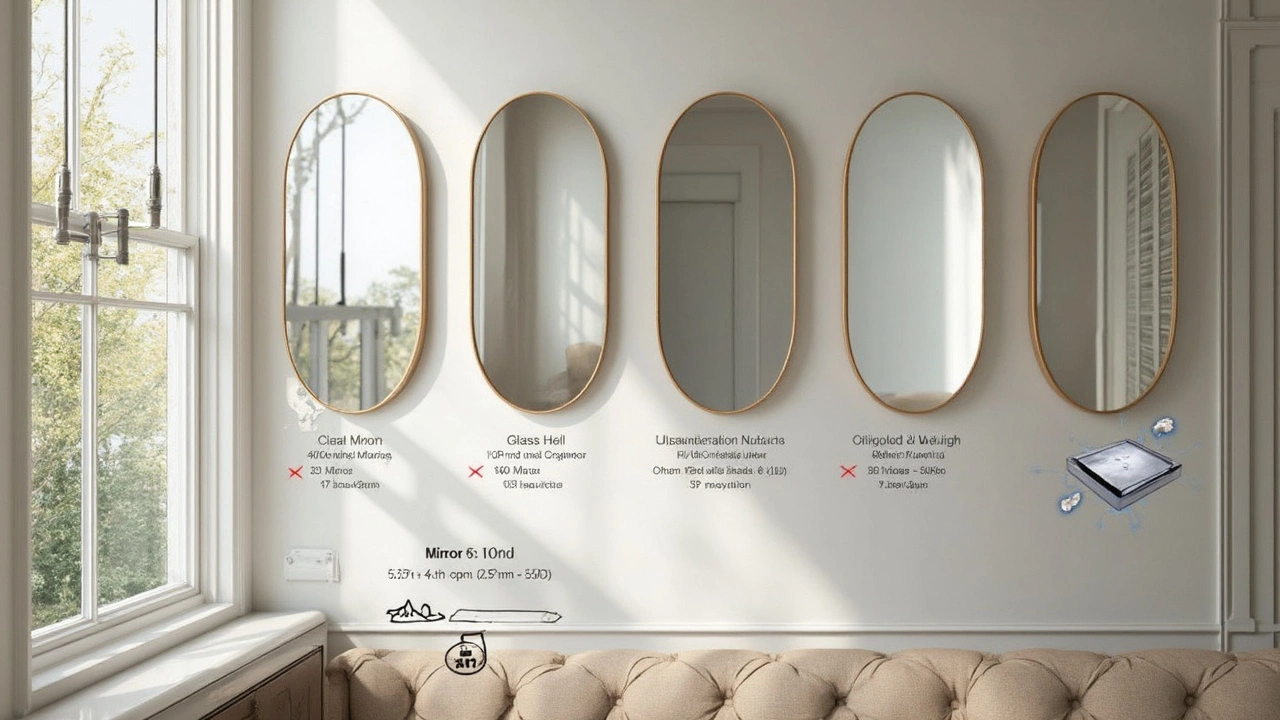Mirror Quality: Are Some Mirrors Really Better Than Others?
 May, 24 2025
May, 24 2025
If you’ve ever looked into a mirror and thought your reflection looked a little off, you’re not imagining things. Some mirrors really do give better reflections than others. Whether you’re fixing your hair, putting on makeup, or just checking your outfit, mirror quality makes a difference—even if you don’t notice it right away.
If you buy a cheap mirror from a discount store and compare it to the ones in a nice hotel, you’ll see what I mean. Price isn’t everything, but there’s a reason high-end mirrors cost more. Think about what’s inside a mirror: mostly glass in the front, with a thin coat of metal (usually silver or aluminum) stuck to the back—that’s what actually makes the reflection happen. The quality of both the glass and the metal matters a lot.
Ever seen a mirror that looks cloudy or wavy around the edges? That’s a sign of poor quality. It could be thin, warped glass or cheap backing that’s started to break down. If you’re picking a mirror for your bathroom where there’s lots of steam, you want one that won’t have those problems after a year or two. Even the thickness of the glass can make a difference—thicker glass generally means a sturdier and flatter mirror.
- What Actually Makes a Mirror High Quality
- Why Some Mirrors Show Clearer Reflections
- Where Quality Really Matters (and Where It Doesn’t)
- Smart Tips for Choosing the Right Mirror
What Actually Makes a Mirror High Quality
Most people just see glass and a shiny surface, but there’s actually a lot going on that separates a great mirror from a meh one. If you want your mirror to last and always show a clear reflection, you need to look for a few key things: glass thickness, quality of the backing material, and the process called silvering.
First up, the glass. High-quality mirrors use glass that’s at least 1/4 inch thick. Thinner glass can warp, which is why some mirrors make your face look stretched or your body look wavy. If you can, tap on the glass and see if it feels solid. Flatter glass means a more accurate reflection—no funhouse mirror effect.
Next is the backing layer. Good mirrors have a layer of pure silver or aluminum behind the glass. Silver is better for a rich, true reflection, but it’s pricier. Most decent bathroom or vanity mirrors use aluminum, which does the job well and resists humidity if it’s coated properly. That extra paint or sealant on the back is more than just looks—it keeps air and water out, preventing those annoying black edges and spots you see on old mirrors.
The silvering process literally decides how your mirror reflects light. Better mirrors use a high-quality, evenly applied metallic layer. Cheap mirrors often have thin or patchy silvering, which can leave your reflection looking dull or hazy.
- Look for glass with consistent thickness—ideally 1/4 inch
- Check for a sturdy, smooth backing with at least two layers of protective paint
- Ask or check if the mirror has a pure silver backing for the best reflection
- Avoid mirrors that feel flimsy or look wavy when you check them from the side
It’s worth it to pay a bit extra for a mirror that gets these basics right. Not only will it look better, but it’ll also last a lot longer before showing signs of wear. If you care about mirror quality, don’t just skim the surface—look for these details.
Why Some Mirrors Show Clearer Reflections
Ever wondered why mirrors at the gym look crisp but the one in your garage feels off? There’s actually a handful of solid reasons. First, let’s talk about the glass itself. Good mirrors use flat, thick glass—usually at least 1/4-inch thick. Thinner glass is more likely to warp, and even tiny ripples mean your reflection can get wavy or stretched in weird ways.
The real MVP, though, is the layer of metal at the back—the shiny stuff that creates the reflection. Most household mirrors use aluminum because it’s cheaper, but high-end mirrors usually get a layer of real silver. Silver gives a brighter, sharper image and tends to hold up better over time, especially in damp places like bathrooms. It’s no accident that old-school barbershop mirrors used real silver, and those reflections are tough to beat.
Manufacturing matters too. A poorly made *mirror* can have little air bubbles, dirt specs, or uneven coating. These flaws can be almost invisible at a glance but add up to a fuzzier reflection. Quality mirrors are made in cleaner conditions, and the coating gets applied more evenly.
- Mirror quality depends a lot on how smooth the glass is—microscopic bumps scatter light and can dull your reflection.
- Silver-backed mirrors in Europe are usually required to pass stricter standards than those in North America, so you’ll sometimes see clearer mirrors on that side of the pond.
- Modern anti-corrosion coatings help mirrors last, too, so the reflective layer won’t break down just from bathroom steam.
Here’s a quick comparison to give you a sense of why quality varies:
| Type | Reflective Layer | Image Clarity | Best For |
|---|---|---|---|
| Budget Mirror | Aluminum | Fair | Closets, garages |
| Standard Mirror | Aluminum or Silver | Good | Bedrooms, living rooms |
| Premium Mirror | Silver (thick coat) | Excellent | Bathrooms, salons |
Bottom line: if you want razor-sharp detail, thick glass and a high-quality silver backing are worth every penny. Don’t just look for a shiny surface. It’s what’s behind the glass that matters for a reflection that really pops.

Where Quality Really Matters (and Where It Doesn’t)
Mirror quality isn’t something you want to gamble with in every room of your house. In bathrooms, for example, moisture is the real enemy. Steam and splashes can sneak behind cheap mirrors and eat away at the metallic coating, causing black spots and streaks. If you’ve ever seen a bubbly, peeling mirror at an old gas station, that’s what happens when the backing fails.
High-use bathrooms, barbershops, salons, and gyms—these are places where mirror quality has to be top notch. Look for mirrors labeled as moisture-resistant or with a copper-free backing, since copper can corrode quickly. Tempered glass is safer if the mirror might get bumped or dropped. For bathrooms and areas with poor ventilation, the extra money spent on a better mirror saves you cash on replacements later.
Now, if you’re putting a mirror somewhere like a guest room or a hallway where it’s just for looks, you can get away with spending less. Fancy anti-fog coatings, ultra-thick glass, or ultra-clear reflections won’t matter much if no one really uses the mirror for up-close grooming.
Here’s a quick comparison of where quality pays off versus where it’s okay to save:
| Room/Use | Needed Quality | Must-Have Features |
|---|---|---|
| Main Bathroom | High | Moisture resistance, thicker glass, quality mounting |
| Dressing Room | High | Clear reflection, good lighting compatibility |
| Hallway/Guest Room | Low to Medium | Looks, basic flatness |
| Gym/Salon | Very High | Safety backing, impact resistance, no distortion |
For renters or students who just need something quick and cheap for a few months, the lowest-grade mirror will get you by. But if you want something that doesn’t get spots, waves, or cracks, especially in a high-traffic spot, don’t skimp—buy once, cry once.
Smart Tips for Choosing the Right Mirror
Picking a good mirror isn’t rocket science, but there’s more to it than grabbing the first one that fits your wall. Want to avoid warping, dull edges, or streaky reflections down the road? Here’s what you should actually look for.
- Mirror quality starts with the glass. Thicker glass (think 1/4 inch rather than 1/8 inch) is less likely to give you a funhouse look. If the mirror feels flimsy and bends easily, move on.
- Check out the silvering—the shiny backing behind the glass. Real silver or high-grade aluminum gives brighter and more accurate reflections. Low-quality mirrors sometimes use cheaper coatings that turn spotty or yellowish after a while. According to Glass Association of North America,
"Proper silvering and copper backing are key to keeping a mirror looking new and preventing black edges."
- Pay attention to the edges. Mirrors with sealed or beveled edges are less likely to develop black spots (that annoying corrosion you see on cheap bathroom mirrors).
- Consider where the mirror will live. Bathrooms and humid spots call for mirrors labeled as moisture-resistant or specifically designed for high-humidity areas. Otherwise, you’ll see that telltale edge rot show up way too soon.
- Test the reflection. Hold a pen or any object right up to the glass. If there’s almost no gap between the object and its reflection, you’re looking at a true reflection—not one distorted by thick glue or low-grade glass. This trick is seriously handy when shopping in person.
And hey, don’t ignore the warranty. Good brands stand behind their mirrors for years, not just a few months. The right mirror is the one that still looks sharp after you’ve mopped up a bathroom flood or burned dinner in front of it. Trust your eyes—and your hands. If it feels heavy, solid, and the reflection is crisp, you’ve probably found a winner.